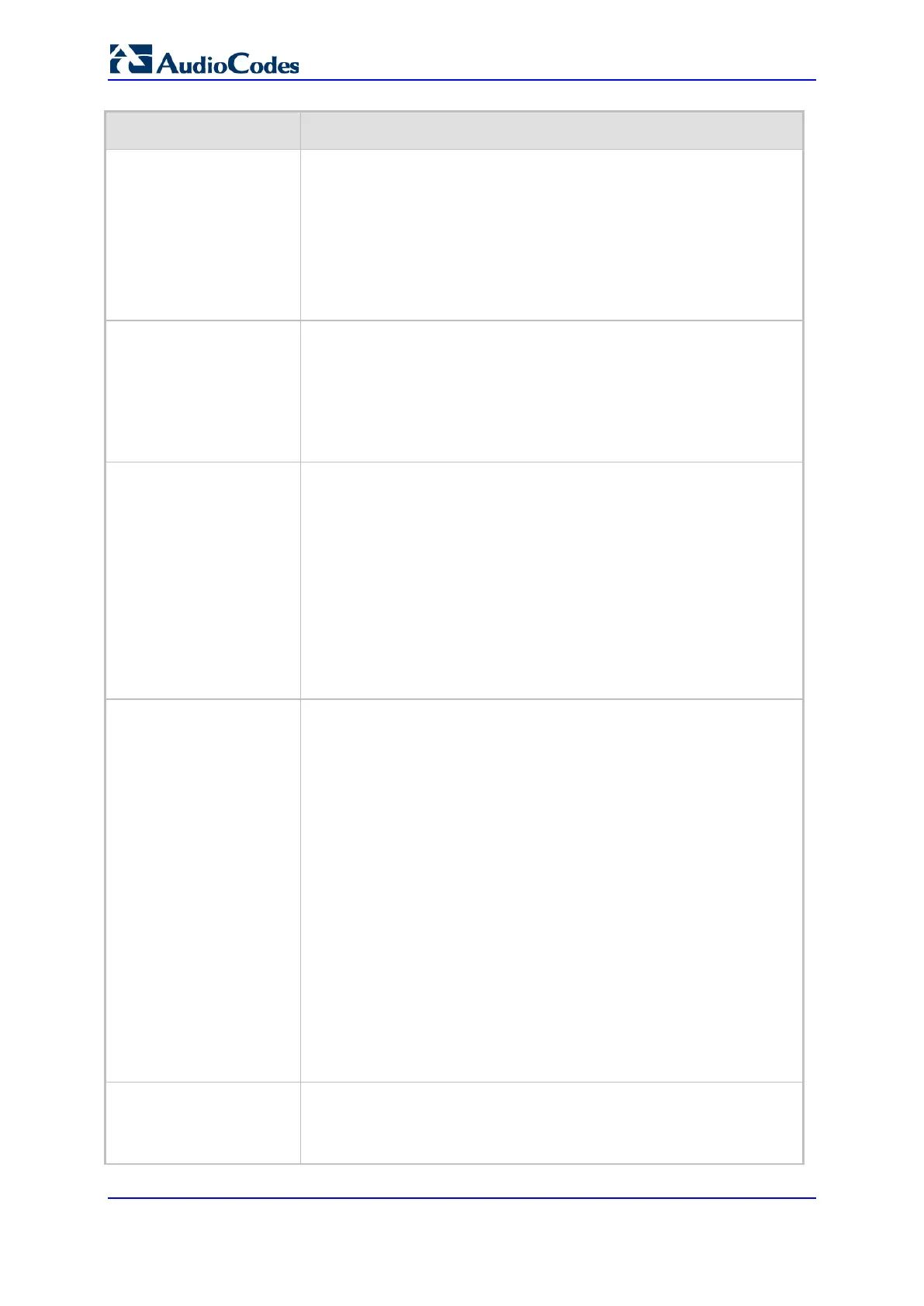User's Manual 684 Document #: LTRT-68822
Mediant 2000
Parameter Description
t]
user is located in the database, the request is sent to the user. If the
user is not found, the request is forwarded to the next redundant SAS
defined in the Redundant SAS Proxy Set. If that SAS Proxy IP appears
in the Via header of the request, it is not forwarded (thereby,
preventing loops in the request's course). If no such redundant SAS
exists, the SAS sends the request to its default gateway (configured by
the parameter SASDefaultGatewayIP).
The valid range is -1 to 5. The default is -1 (i.e., no redundant Proxy
Set).
Web/EMS: SAS Block
Unregistered Users
[SASBlockUnRegUsers]
Determines whether the device rejects SIP INVITE requests received
from unregistered SAS users. This applies to SAS Normal and
Emergency modes.
[0] Un-Block = (Default) Allow INVITE from unregistered SAS
users.
[1] Block = Reject dialog-establishment requests from un-registered
SAS users.
[SASEnableContactRepl
ace]
Enables the device to change the SIP Contact header so that it points
to the SAS host and therefore, the top-most SIP Via header and the
Contact header point to the same host.
[0] (default) = Disable - when relaying requests, the SAS agent
adds a new Via header (with the SAS IP address) as the top-most
Via header and retains the original Contact header. Thus, the top-
most Via header and the Contact header point to different hosts.
[1] = Enable - the device changes the Contact header so that it
points to the SAS host and therefore, the top-most Via header and
the Contact header point to the same host.
Note: Operating in this mode causes all incoming dialog requests to
traverse the SAS, which may cause load problems.
Web: SAS Survivability
Mode
EMS: Survivability Mode
[SASSurvivabilityMode]
Determines the Survivability mode used by the SAS application.
[0] Standard = (Default) Incoming INVITE and REGISTER requests
are forwarded to the defined Proxy list of SASProxySet in Normal
mode and handled by the SAS application in Emergency mode.
[1] Always Emergency = The SAS application does not use Keep-
Alive messages towards the SASProxySet, instead it always
operates in Emergency mode (as if no Proxy in the SASProxySet is
available).
[2] Ignore Register = Use regular SAS Normal/Emergency logic
(same as option [0]), but when in Normal mode incoming
REGISTER requests are ignored.
[3] Auto-answer REGISTER = When in Normal mode, the device
responds to received REGISTER requests by sending a SIP 200
OK (instead of relaying the registration requests to a Proxy), and
enters the registrations in its SAS database.
[4] Use Routing Table only in Normal mode = The device uses the
IP-to-IP Routing table to route IP-to-IP SAS calls only when in SAS
Normal mode (and is unavailable when SAS is in Emergency
mode). This allows routing of SAS IP-to-IP calls to different
destinations (and not only to the SAS Proxy Set).
Web: SAS Subscribe
Response
[SASSubscribeRespons
e]
Defines the SIP response upon receipt of a SUBSCRIBE message
when SAS is in Emergency mode. For example, if this parameter is set
to "200", then SAS sends a SIP 200 OK in response to a SUBSCRIBE
message, when in Emergency mode.

